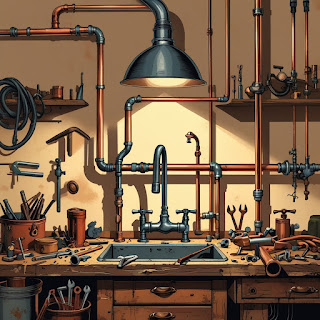Whether you're a seasoned DIYer or a beginner tackling plumbing issues, knowing the right tricks can save time, money, and frustration. Plumbing problems, if left unresolved, can escalate quickly into costly repairs, but with the right approach, many issues are manageable by homeowners. We explore expert plumbing techniques, tools, and tips that will ensure your next DIY plumbing project is a success.
Understanding Common Plumbing Issues and How to Address Them
1. The Power of Preventative Maintenance
Preventative maintenance is the cornerstone of good plumbing. Regular checks for leaks, corrosion, and wear and tear on pipes can prevent larger problems later on. It's essential to inspect areas like faucets, showerheads, and under-sink piping every six months to ensure that everything is in working order.
- Tip: Replace any worn-out washers in faucets to prevent slow drips, which can waste water and increase your water bill.
2. How to Efficiently Reheat Soldered Pipe Joints
Reheating soldered pipe joints is a technique used by many plumbers to repair or remove fittings without needing to cut pipes. While cutting is often the best approach, some situations require alternative methods, especially when working in tight spaces.
- Method: Heat the pipe joint using a propane torch. Once the solder melts, you can easily pull off the fitting. Be sure to use a wet rag to wipe away molten solder to prevent it from solidifying before you’re ready.
3. Upgrade to Plastic Drain Lines for Easier Maintenance
Although metal drain lines may seem durable, plastic drain lines are often a more efficient and long-lasting option. They are less prone to corrosion and leaks and are easier to install.
- Tip: Replace old metal pipes with modern PVC or ABS plastic pipes. These are inexpensive and easy to install, and they’ll save you from costly repairs due to rust and corrosion.
Advanced Plumbing Tricks for Difficult Situations
4. Loosening Stuck Pipes Using Heat
Over time, threaded connections can become stuck due to mineral deposits, corrosion, or hardened sealant. Applying heat is a highly effective way to loosen a stubborn connection.
- Tip: Use a heat gun or propane torch to gently heat the pipe until it expands slightly. This can break the bond created by corrosion or old sealant, making it easier to unscrew the pipe.
Important: Always exercise caution when using heat around plastic materials or near sensitive surfaces. Never apply heat to gas lines or plastic pipe threads.
5. Piggyback Shutoff Valves for Quick Repairs
A common problem in plumbing systems is a malfunctioning shutoff valve. Rather than replacing the entire shutoff valve, which can be labor-intensive, installing a piggyback valve allows you to bypass the damaged valve while retaining the original fixture.
- Tip: Install a piggyback valve if your current shutoff valve is leaking or unable to fully close. This allows you to control water flow without shutting off the main supply.
Essential Plumbing Tools and Techniques for DIY Success
6. The Importance of Proper Pipe Threading with Teflon Tape
Using Teflon tape, also known as plumber’s tape, is crucial for creating a leak-proof seal when connecting threaded pipe joints. Proper application ensures a tight seal without leaks, especially when working with water pipes.
- Tip: Wrap Teflon tape clockwise around the pipe threads before making the connection. Three wraps are typically sufficient, but always check the manufacturer’s instructions for specific guidelines.
7. Replacing Corroded Faucets and Fixtures
If you notice leaks or difficulty in turning your faucet, it may be time for a replacement. While DIY faucet repairs are possible, replacing the entire fixture is often the best option for ensuring long-term functionality.
- Tip: When replacing a faucet, choose models with durable materials such as brass or stainless steel. These materials are more resistant to corrosion and provide reliable service for years.
8. Using Pipe Dope for Sealing and Lubrication
Pipe dope, a type of thread sealant, helps create a strong seal on threaded connections and is often used in conjunction with Teflon tape. Unlike tape, pipe dope can be applied to a wider variety of connections, including compression fittings.
- Tip: For easier disassembly later, opt for a non-hardening pipe dope that remains pliable even after years of use.
Time-Saving Techniques for Everyday Plumbing Tasks
9. Clearing Clogs Without a Drain Snake
Drain clogs are common, but you don’t always need a snake to clear them. A variety of tools can help remove blockages quickly without requiring you to disassemble the pipes.
- Tip: Use a flexible-shaft pick-up tool or a Zip-It drain cleaner to remove hair and debris from the pipe. A wet/dry vacuum is also an excellent tool for sucking out clogs from drains.
10. Don’t Over-tighten Supply Lines
When installing supply lines, it’s easy to get carried away and tighten connections too much. However, overtightening can cause threads to strip or damage rubber seals, leading to future leaks.
- Tip: Tighten connections until they are hand-tight, then give them an additional one-quarter turn using pliers. If a leak develops, adjust the connection until it’s sealed.
Mastering Plumbing with the Right Knowledge and Tools
By applying these expert plumbing techniques, you can tackle common plumbing problems with confidence and efficiency. Whether you’re replacing a faucet, repairing a clogged drain, or working with pipes in tight spaces, the right tools and methods can save you both time and money.
Remember that plumbing isn’t just about fixing problems—it's about maintaining your home’s systems to prevent future issues. Regular maintenance, smart upgrades, and using the right techniques will ensure your plumbing remains in top shape for years to come.
By following these tips and utilizing the best tools and techniques, you can become an expert in plumbing, tackling even the most challenging projects with ease. With careful attention to detail and the right approach, you'll be able to keep your plumbing in top condition, avoiding expensive repairs and

No comments:
Post a Comment